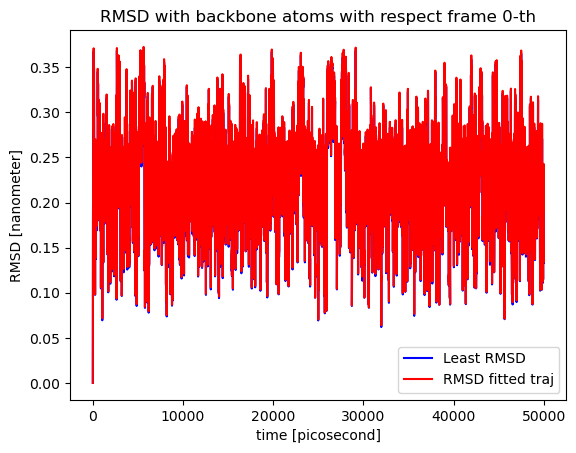%load_ext autoreload
%autoreload 2
import molsysmt as msm
from molsysmt import pyunitwizard as puw
import numpy as np
import matplotlib.pyplot as plt
Least RMSD fit#
Lets load a small molecular system with a 5000 frames trajectory to show how MolSysMT gets the RMSD, the least RMSD, or the least RMSD fitted structures over a reference frame.
h5_file = msm.systems['pentalanine']['traj_pentalanine.h5']
molecular_system = msm.convert(h5_file)
msm.info(molecular_system)
| form | n_atoms | n_groups | n_components | n_chains | n_molecules | n_entities | n_peptides | n_structures |
|---|---|---|---|---|---|---|---|---|
| molsysmt.MolSys | 62 | 7 | 1 | 1 | 1 | 1 | 1 | 5000 |
#msm.view(molecular_system, standard=True)
Least RMSD fit#
The same method to compute the least RMSD [1] implemented in molsysmt.rmsd() provides with the translational and rotational operators that makes the RMSD minimal. This two operators, applied to the original structure, results with the best fitted structure over the reference one. MolSysMT includes a specific function to execute this least RMSD fitting: molsysmt.least_rmsd_fit(). All input arguments of molsysmt.rmsd() can be used with molsysmt.least_rmsd_fit(). Lets see a couple of examples:
fitted_molecular_system = msm.structure.least_rmsd_fit(molecular_system, selection='backbone',
structure_indices='all', reference_structure_index=0,
to_form='molsysmt.MolSys')
#msm.view(fitted_molecular_system, standard=True)
Take heed to the input argument to_form, the above cell results with a new molecular system with the form specified by the former argument. Lets check the RMSD of the new frames over the frame 0-th. We can compare it with the result of molsysmt.least_rmsd():
fitted_rmsd = msm.structure.get_rmsd(fitted_molecular_system, selection='backbone',
structure_indices='all', reference_structure_index=0)
lrmsd = msm.structure.get_least_rmsd(molecular_system, selection='backbone',
structure_indices='all', reference_structure_index=0)
time = msm.get(molecular_system, time=True)
plt.plot(time, lrmsd, color='blue', label='Least RMSD')
plt.plot(time, fitted_rmsd, color='red', label='RMSD fitted traj')
plt.xlabel('time [{}]'.format(puw.get_unit(time)))
plt.ylabel('RMSD [{}]'.format(puw.get_unit(lrmsd)))
plt.title('RMSD with backbone atoms with respect frame 0-th')
plt.legend()
plt.show()
/home/diego/Myopt/miniconda3/envs/MolSysMT@uibcdf_3.12/lib/python3.12/site-packages/matplotlib/cbook.py:1345: UnitStrippedWarning: The unit of the quantity is stripped when downcasting to ndarray.
return np.asarray(x, float)

[1] Coutsias, Evangelos A., Chaok Seok, and Ken A. Dill. “Using quaternions to calculate RMSD.” Journal of computational chemistry 25, no. 15 (2004): 1849-1857